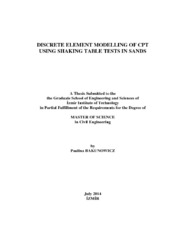Please use this identifier to cite or link to this item:
https://hdl.handle.net/11147/4220Full metadata record
| DC Field | Value | Language |
|---|---|---|
| dc.contributor.advisor | Ecemiş, Nurhan | - |
| dc.contributor.author | Bakunowicz, Paulina | - |
| dc.date.accessioned | 2014-12-03T08:46:03Z | - |
| dc.date.available | 2014-12-03T08:46:03Z | - |
| dc.date.issued | 2014-07 | - |
| dc.identifier.uri | http://hdl.handle.net/11147/4220 | - |
| dc.description | Thesis (Master)--Izmir Institute of Technology, Civil Engineering, Izmir, 2014 | en_US |
| dc.description | Includes bibliographical references (leaves: 137-143) | en_US |
| dc.description | Text in English; Abstract: Turkish an English | en |
| dc.description | Full text release delayed at author's request until 2015.02.14 | en |
| dc.description.abstract | This thesis contains an overview of the results obtained from detailed study exploring the ability of two-dimensional discrete element method (2D DEM) models to reproduce cone penetration tests in saturated sand deposits. The simulations of the cone penetration and triaxial tests are carried out under application of the commercially available numerical analysis software PFC2D (Itasca, 2008). This software is based on DEM with additional basic fluid analysis option. The soil sample used in the laboratory experiments was uniform, river clean quartz sand, which was similar to Ottawa sand. The material properties that required calibration were normal stiffness, tangential stiffness and interparticle friction. These parameters were determined by trial and error from 2D DEM biaxial test simulations. Data from five laminar box shaking table tests of saturated sand was analysed with particular attention to the measured cone penetration resistance in assemblages deposited at various relative densities. Each shake table test was subjected to three series of shaking tests (at the same intensities) by using one-degree of freedom shaking table system, which allowed obtaining wide scope of different porosities. A new scaling factor was implemented in order to compare the data obtained from tests on real soil (3D) with numerical simulations by DEM (2D). Observations of the behaviour of discrete material at laminar box enabled us to make a correlation between porosity from large scale experiment and PFC2D model. To examine the effects of boundary conditions, porosity, particle diameter size, fluid grid dimensions, contacts, coordination number and others on the tip resistance value, multiple simulation tests were performed. From the results presented we can deduce that 2D DEM CPT model can be powerful tool to enrich the conventional physical calibration tests. In this thesis it is also proven that CPT laminar box based correlations facilitate to overcome limitations of 2D simulation and can be widely and successfully applied for both scientific research and engineering practice purposes. | en_US |
| dc.description.sponsorship | PIRG05-GA-2009-248218, TÜBİTAK (110M602) and İYTE-BAP (2010İYTE14) | en_US |
| dc.language.iso | en | en_US |
| dc.publisher | Izmir Institute of Technology | en_US |
| dc.rights | info:eu-repo/semantics/openAccess | en_US |
| dc.subject | Geomechanics | en_US |
| dc.subject | Geotectonical properties | en_US |
| dc.subject | Geotectonical exploration | en_US |
| dc.subject | Cone penetration test | en_US |
| dc.subject | Relative density | en_US |
| dc.subject | Granular material | en_US |
| dc.title | Discrete element modelling of CPT using shaking table tests in sands | en_US |
| dc.title.alternative | Kumlarda sarma tablası deneyleri kullanılarak CPT testinin ayrık eleman yöntemi ile modellenmesi | en_US |
| dc.type | Master Thesis | en_US |
| dc.institutionauthor | Bakunowicz, Paulina | - |
| dc.department | Thesis (Master)--İzmir Institute of Technology, Civil Engineering | en_US |
| dc.relation.publicationcategory | Tez | en_US |
| item.openairecristype | http://purl.org/coar/resource_type/c_18cf | - |
| item.grantfulltext | open | - |
| item.cerifentitytype | Publications | - |
| item.fulltext | With Fulltext | - |
| item.openairetype | Master Thesis | - |
| item.languageiso639-1 | en | - |
| Appears in Collections: | Master Degree / Yüksek Lisans Tezleri | |
Files in This Item:
| File | Description | Size | Format | |
|---|---|---|---|---|
| 10013388.pdf | MasterThesis | 5.13 MB | Adobe PDF |  View/Open |
CORE Recommender
Page view(s)
238
checked on Nov 25, 2024
Download(s)
196
checked on Nov 25, 2024
Google ScholarTM
Check
Items in GCRIS Repository are protected by copyright, with all rights reserved, unless otherwise indicated.